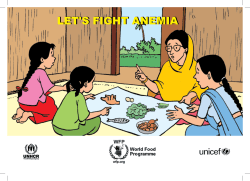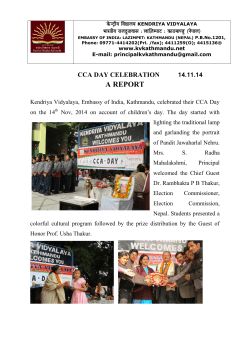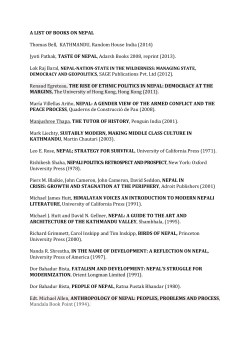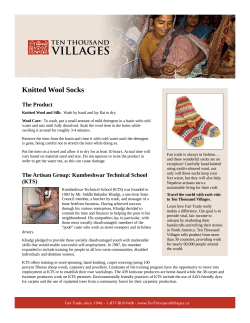
meena and the magic micronutrients meena and the magic
MEENA AND THE MAGIC MICRONUTRIENTS Developed by: Bhawana Thapaliya (WFP – Nepal) Ilaria Schibba (WFP – Nepal) Sanne Bakker (WFP – Nepal) Project Supervisor: Marco Cavalcante (WFP – Nepal) Technical Consultation: Katrien Ghoos (WFP – Regional Bureau for Asia) Lindsey Horton (WFP – Regional Bureau for Asia) Sanju Bhattarai (UNICEF – Nepal) Pradiumna Dahal (UNICEF - Nepal) Lakruwan Dassanayake (UNHCR - Nepal) Nini Gurung (UNHCR - Nepal) Salina Khatoon (UNHCR - Nepal) Illustrations and Design: The Image Creators P. Ltd. Translations: Bhawana Thapaliya (WFP – Nepal) Pushpa Sunuwar (WFP – Nepal) Project Management (WFP Nepal): Ilaria Schibba Kishor Aryal Kishor Rai Pramila Ghimire Pushpa Sunuwar Sanne Bakker Subhash Singh Bhawana Thapaliya Jagdish Pant Kamal Dhungana Prabin Shrestha Special Thanks to: Shrid Dhungel Anusara Singhkumarwong Nicole Menage (WFP - Nepal) Hanaa Singer (UNICEF - Nepal) Craig Sanders (UNHCR - Nepal) Meena is a little girl who lives in a village with her parents, her grandmother, her brother Raju and her baby sister Rani. Mithu the parrot is her best friend. She is friendly. She is not afraid to ask questions. She solves problems and shows you all the things a little girl can do. 3 Today the teacher is talking about healthy diet. The teacher explains that it is very important to vary the diet. Instead of eating the same foods every day, it is much better to consume many different food items. It will make you grow and stay healthy. Instead of eating an apple every day, you should eat different types of fruits and vegetables. 4 The teacher explains about micronutrients, the magical micronutrients. They are very small and they live in the foods we eat. They especially like living in fruits, vegetables, fish, meat, egg and Supercereal. For example papaya, egg, cauliflower and this radish contain many of the magic nutrients! 5 The teacher shows the big poster with foods rich in micronutrients and asks the children to color the images. 6 For pregnant women, young children, ill patients the magic micronutrients are very important. They need them more than anyone else. If there are pregnant women, young children, ill patients in your family, make sure that they eat the foods that you see on the poster. My neighbor Neeti didi has a little child. I will pass on the message. 7 Meena shows the poster with foods rich in micronutrients to Neeti didi. She is worried that the food she provides to her seven months old child does not contain enough micronutrients. My teacher told us that micronutrients are especially important for pregnant women and young children. 8 Neeti didi realizes her child is less active and falls sick more often than other children. Could it be due to a lack of micronutrients? Let’s go to the nearest health center and seek the health workers’ advice. Let’s see what they will suggest. 9 The health worker confirms that it is important to eat foods rich in micronutrients. And, that indeed, a child may become less active and fall sick more often when the micronutrient requirements are not met. It is very important to eat foods rich in micronutrients. 10 For the extra micronutrient requirements of young children, WFP is providing micronutrient powders (MNP). If we add MNP to food it will be more nutritious. MNP are distributed by the health centers for children aged between 6 and 59 months. They should be consumed every alternate day. These are the micronutrients! 11 You can add us to your food, and once in your body we will do everything we can do to make you feel active and to fight sickness agents. Namaste! We are the micronutrients (MNP)! 12 WFP also distributes Supercereal which contains micronutrients for the human body. So never waste Supercereal and eat it all! Supercereal is provided to every family member. It is also provided to undernourished children, pregnant and lactating women together with fortified vegetable oil. 13 Neeti didi shares informations with other mothers. Their children have better appetite, energy level, and health when they add MNP sprinkles to the children's food. Sometimes the color of the food changes after mixing it, but the MNP sprinkles are safe for the child. And they are also tasteless. Let’s go home and prepare food. 14 MNP sprinkles should be added only to the food for all children aged between 6 and 59 months. It should not be shared with other family members. I am for all children aged between 6 and 59 months. 15 Neeti didi is always responsive to Buddi’s clues for hunger and also encourages him to eat and she never forgets to add MNP sprinkles to his food every alternate day. MNP should be added to semi–solid food which is ready for consumption. Looking at Buddi having food, I am also feeling hungry. Wait for a while Meena! After feeding Buddi, I will prepare nutritious haluwa with Supercereal for us. 16 Meena can do this calculation: 15 sachets for 30 days that means 1 sachet every other day. I receive 15 MNP sachets per month. 17 Supercereal can be cooked in various ways and can be eaten as haluwa, satu, roti, and can be even made into yummy ladoos. Neeti didi prepares Supercereal haluwa for Meena. What are Supercereal’s ingredients? Supercereal is made of wheat, soya and is fortified with micronutrients. 18 Magic micronutrients are our best friends; healthy foods and Supercereal give us micronutrients. We should never forget about the micronutrients sprinkles for our little ones! 19
© Copyright 2025










